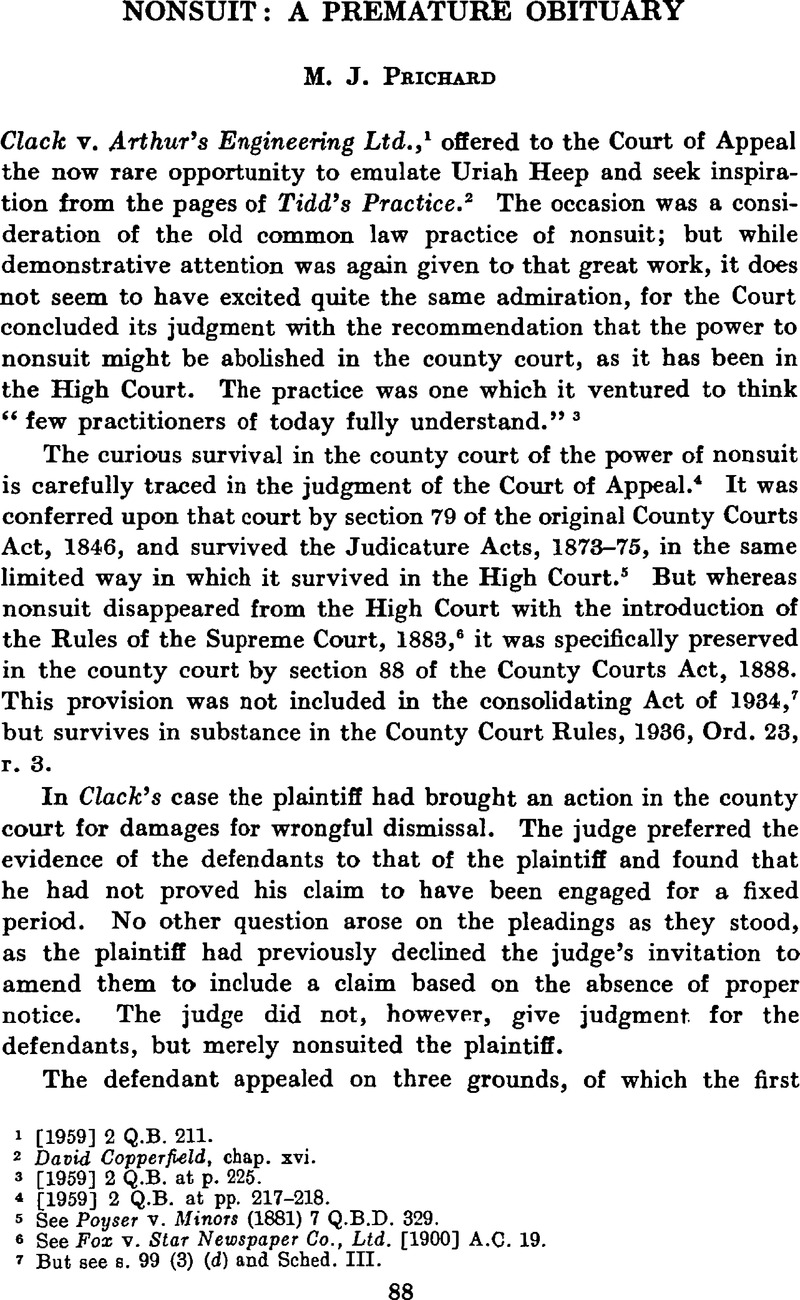Article contents
Nonsuit: A Premature Obituary
Published online by Cambridge University Press: 16 January 2009
Abstract

- Type
- Obituary
- Information
- Copyright
- Copyright © Cambridge Law Journal and Contributors 1960
References
1 [1959] 2 Q.B. 211.
2 David Copperfield, chap. xvi.
3 [1959] 2 Q.B. at p. 225.
4 [1959] 2 Q.B. at pp. 217–218.
5 See Poyser v. Minors (1881) 7 Q.B.D. 329.
6 See Fox v. Star Newspaper Co., Ltd. [1900] A.C. 19.Google Scholar
7 But see s. 99 (3) (d) and Sched. III.
8 [1959] 2 Q.B. at p. 218.
9 Ibid. at pp. 221–222.
10 Or, where there was no jury, once the judge had found the facts. Cf. Snelling v. Norton (1595) Cro.Eliz. 409.
11 [1959] 2 Q.B. at pp. 221–222.
12 Com.Dig., Pleader (X.4.).
13 Co.Lit. 139b.
14 Y.B. 6 Edw. 2, S.S. vol. 43, p. 134.
15 Y.B. 12 Edw. 2, S.S. vol. 65, p. 145.
16 Tidd's Practical Forms (8th ed., (1840) p. 323.
17 Vin.Abr., Nonsuit (D).
18 Ibid. Nonsuit (C). A nolle prosequi was necessary.
19 See, e.g., Y.B. 6 Edw. 2, S.S. vol. 43, pp. 91, 94–95, 120–121.
20 Macbeath v. Haldimand (1786) 1 T.R. at p. 176; Watkins v. Towers (1788) 2 T.R. at p. 281.
21 [1959] 2 Q.B. at pp. 221–222. It conceded that a nonsuit against the plaintiff's wishes at any earlier stage was inadmissible.
22 Tidd's Practice (9th ed., 1828), vol. 2, p. 867.
23 Ibid. at p. 869.
24 (1827) 6 B. & C. 225.
25 See Bayley J., ibid. at p. 231.
26 (1835) 4 N. & M. 633.
27 See, e.g., Holdsworth, H.E.L., vol. 1, p. 643; Sir Raymond, Evershed, The Court of Appeal in England (1950) pp. 5–6.Google Scholar
28 See Stephen on Pleading, chap. 1.
29 Cox v. Kitchin (1798) 1 B. & P. at p. 339, per Buller J.
30 Bro.Abr., Assise, 32.
31 Cited Thayer, Evidence, p. 241, n. 1. Holdsworth, H.E.L., vol. 1, pp. 282–283; but cf. vol. 9, pp. 277–278. Sutton, Personal Actions, pp. 129, 133. Elementary textbooks on the legal system appear to ignore the development.
32 Cf. Tidd, op. cit. vol. 2, p. 900; Stephen on Pleading, 5th ed., p. 103. I am indebted to Professor H. A. Hollond, who first drew my attention to the absence of any account of this practice several years ago.
33 Tidd, op. cit. vol. 2, p. 898.
34 Apart, of course, from a motion for a new trial. Special verdicts were cumbersome.
35 Kemp's Case (1745) Barnes 455; Moyse v. Cocksedge (1749) Barnes 459. Cf. Willes 636, and at pp. 192–193.
36 Mead v. Robinson (1743?) Barnes 451.
37 Tidd, op. cit. vol. 2, pp. 898–899; Sutton, op. cit. p. 134.
38 See, e.g., Parsons v. Thompson (1790) 1 H.Bl. 322.
39 Stephen, op. cit. p. 102. Cf. Chandler v. The Hundred of Sunning (1749) Barnes 458.
40 See, e.g., Norris v. Napper (1704) 2 Ld.Raym. 1007; Gravely v. Ford (1705) 2 Ld.Raym. 1209; Dale v. Lubbock (1729) 1 Barn.K.B. 199; Jury v. Glover (1729) 1 Barn.K.B. 200.
41 See Baskerville v. Brown (1761) 2 Burr. 1229; Dally v. Smith (1768) 4 Burr. 2148; Saunderson v. Rowles (1771) 4 Burr. 2064. Cf. Dale v. Sollet (1767) 4 Burr. 2133 (special case?). Tidd, op. cit. vol. 2, p. 900 (d) cites earlier cases, but these appear to be examples of special case. The new procedure may perhaps be traced back to the time of Holt C.J.; Greene v. Crane (1705) 2 Ld.Raym. 1101; Lamine v. Dorrell (1705) 2 Ld.Raym. 1216; Lock v. Hayton, Fort. 246; Depaba v. Ludlow (1720) 1 Comyns 360; but these may also be instances of special case; cf. Buckmyr v. Darnall (1704) 2 Ld.Raym. 1085.
42 As, for example, in ejectment, where a verdict did not bar a subsequent action.
43 See, e.g., Clay v. Willan (1789) 1 H.Bl. 298; Graff v. Greffuhle (1807) 1 Camp.N.P. 89.
44 See Wymer v. Page (1814) 1 Stark. 9; J. Chitty, Practice of the Law (2nd ed., 1838), vol. 4, p. 915. By the time of the Judicature Acts, the great majority of “Nisi Prius cases” seem to have come to Westminster in this way. See, e.g., the first volumes of the Law Reports, L.R. 1 Q.B. and L.R. 1 C.P.
45 The Judicature Commission, 1st Report, at p. 15; 1868–69 [4130] xxv.
46 Supreme Court of Judicature Act, 1873, s. 46; Supreme Court of Judicature Act, 1875, Sched. I, Ord. 36, r. 22, Ord. 40, r. 2.
47 ss. 15, 17; R.S.C., December 1876. Cf. Yetts v. Foster (1878) 3 C.P.D. 437 and compare R.S.C., 1883, Ord. 36, r. 39, Ord. 40, rr. 2–5, with the rules cited in note 46, supra.
48 See Annual Practice, 1960Google Scholar, note to Ord. 58, r. 2. Even this survival was much narrowed by the rule that a person dissatisfied with the findings of a judge sitting alone must appeal and should not move for a new trial. See Potter v. Cotton (1879) 5 Ex.D. 137.
- 2
- Cited by


